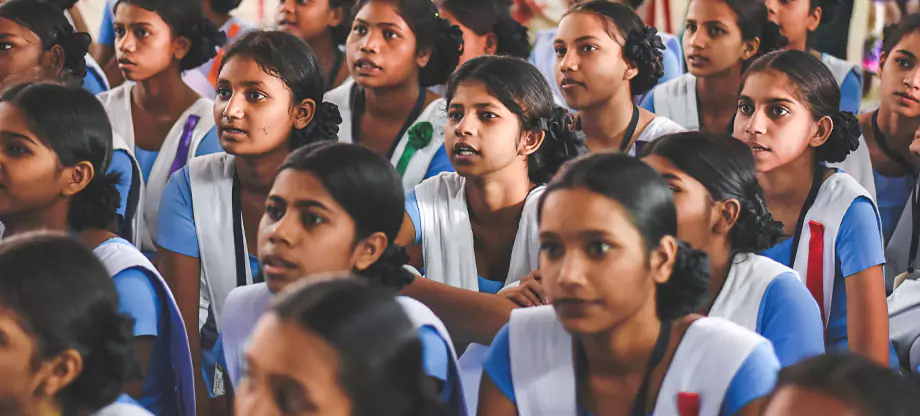10 Years of BBBP
The Beti Bachao, Beti Padhao (BBBP) scheme was launched on January 22, 2015 , by Prime Minister Narendra Modi in Panipat, Haryana . It was introduced as a response to the declining Child Sex Ratio (CSR) and aims to ensure the survival, protection, and education of the girl child .
Now in its 10th year , the scheme has seen significant progress in gender equality , though challenges remain.
Objectives of BBBP
- Improve Child Sex Ratio (CSR) and prevent gender-biased sex selection.
- Ensure survival and protection of the girl child through healthcare and institutional support.
- Promote education and participation of girls by increasing school enrollment and reducing dropouts.
- Raise awareness to challenge societal biases and discriminatory practices.

Achievements of BBBP
Improvement in Sex Ratio at Birth (SRB)
- SRB increased from 918 girls per 1,000 boys in 2014-15 to 930 in 2023-24 .
- Districts with historically low SRB, like Mahendragarh and Jhajjar (Haryana) , reported improvements.
- Awareness campaigns like "Selfie with Daughter" changed public perception about girl children.
Prevention of Female Foeticide
- Implementation of the Pre-Conception and Pre-Natal Diagnostic Techniques (PCPNDT) Act to prevent gender-biased sex selection.
- Community initiatives like "Beti Janmotsav" (celebrating the birth of a girl child) gained traction.
Improvement in Girls' Education
- Gross Enrollment Ratio (GER) for girls in secondary education increased from 75.51% (2014-15) to 78% (2023-24) .
- "Kanya Shiksha Pravesh Utsav" initiative helped re-enroll over 100,000 out-of-school girls .
- Expansion of Kasturba Gandhi Balika Vidyalayas (KGBV) to provide education to disadvantaged girls.
Maternal and Child Healthcare
- Institutional deliveries rose from 61% (2014-15) to over 97.3% (2023-24) .
- Improvement in maternal and infant mortality rates due to better healthcare access.
Economic Empowerment
- Collaboration with the Ministry of Skill Development & Entrepreneurship for skill development programs .
- "Betiyan Bane Kushal" program trained young women for economic independence .
- Sukanya Samriddhi Yojana (SSY) promoted financial security for girls by enabling parents to save for their daughters' future.
Integration with Mission Shakti (2021-2026)
The integration of BBBP with Mission Shakti under the 15th Finance Commission period (2021-26) added two sub-schemes:
-
Sambal (Safety & Security)
- One-Stop Centres, Women Helplines (181) , and expansion of BBBP.
-
Samarthya (Empowerment & Welfare)
- Sakhi Niwas for working women.
- Pradhan Mantri Matru Vandana Yojana (PMMVY) now supports a second child if it is a girl .
Challenges in Implementation
Cultural and Societal Resistance
- Deep-rooted patriarchal norms still hinder progress in many regions.
- Changing mindsets requires sustained community engagement and education .
Uneven Resource Allocation
- Some districts receive more funds than others , leading to disparities in implementation .
- Need for equitable distribution of financial and administrative resources.
Monitoring and Evaluation Issues
- Lack of robust tracking mechanisms to assess the effectiveness of interventions.
- Strengthening data collection and impact assessment is crucial.
- Despite progress, many girls drop out at the secondary and higher secondary levels .
- Need for incentives (scholarships, transport facilities, hostel facilities) to retain them in schools.
- Once infamous for gender discrimination , Haryana improved its Sex Ratio at Birth (SRB) from 879 (2015) to 922 (2023) .
- Strict enforcement of PCPNDT Act and grassroots awareness campaigns .
- Rajiv Gandhi Balika Vidyalaya program expanded girls’ access to education.
- Boarding schools in remote areas reduced dropout rates .
- "Kanya Utthan Yojana" provided financial incentives for girls' education and legal-age marriage.
- Helped reduce child marriages and empowered young women .
- China's "Care for Girls" program aims to promote gender equality and support single-child families with daughters .
- Rwanda’s policies focus on women's empowerment and gender-balanced governance .
- India’s BBBP draws lessons from global models , emphasizing the need for continuous innovation and adaptation .
- Strengthening Community Engagement: More grassroots participation to change social attitudes towards girls.
- Policy Innovations: New, inclusive policies to meet evolving needs of women and girls.
- Digital Education & Awareness: Expanding digital education initiatives for girls in remote and rural areas .
- Economic Opportunities for Women: Scaling up skill development and creating more employment opportunities for women.
School Dropout Rates Among Girls
Best Practices & Success Stories
Haryana – Model of Transformation
Rajasthan – Promoting Girls' Education
Bihar – Financial Empowerment
International Comparisons
The Road Ahead – Future Priorities
Vision for a Gender-Equal Future
As BBBP completes a decade, its impact on gender equality and women’s empowerment is evident. However, sustained efforts, policy innovations, and community participation are needed to ensure long-term success .
With continued focus, India’s vision of "Viksit Bharat 2047" can be achieved through women-led development , ensuring that daughters are not just born but celebrated, educated, and empowered to lead the nation’s progress.













